NCERT SOLUTIONS FOR CLASS 12 MATHS CHAPTER 1-RELATIONS AND FUNCTIONS EXERCISE 1.2
NCERT solutions for class 12 maths Chapter 1 Relation and Functions is prepared by the academic team of Nashad.in, We have prepared NCERT Solutions for all exercises of chapter 1. Given below is a step-by-step solution to all questions given in the NCERT textbook for Chapter 1 Relations and Functions.
Question1. Show that the function f: R* → R* defined by f(x) = 1/x is one-one and onto, where: R* is the set of all non-zero real numbers. Is the result true, if the domain: R* is replaced by N with the co-domain being the same as R*?
Solution :
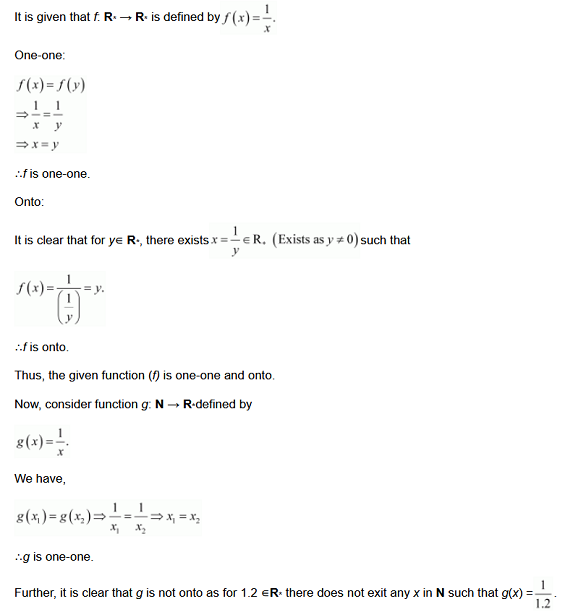
Hence, function g is one-one but not onto.
Question2. Check the injectivity and surjectivity of the following functions:
(i) f: N → N given by f(x) = x2
(ii) f: Z → Z given by f(x) = x2
(iii) f: R → R given by f(x) = x2
(iv) f: N → N given by f(x) = x3
(v) f: Z → Z given by f(x) = x3
Solution :
(i) f: N → N is given by,
f(x) = x2
It is seen that for x, y ∈N, f(x) = f(y)
⇒ x2 = y2 ⇒ x = y.
∴f is injective.
Now, 2 ∈ N. But, there does not exist any x in N such that f(x) = x2 = 2.
∴ f is not surjective.
Hence, function f is injective but not surjective.
(ii) f: Z → Z is given by,
f(x) = x2
It is seen that f(−1) = f(1) = 1, but −1 ≠ 1.
∴ f is not injective.
Now,−2 ∈ Z. But, there does not exist any element x ∈Z such that f(x) = x2 = −2.
∴ f is not surjective.
Hence, function f is neither injective nor surjective.
(iii) f: R → R is given by,
f(x) = x2
It is seen that f(−1) = f(1) = 1, but −1 ≠ 1.
∴ f is not injective.
Now,−2 ∈ R. But, there does not exist any element x ∈ R such that f(x) = x2 = −2.
∴ f is not surjective.
Hence, function f is neither injective nor surjective.
(iv) f: N → N given by,
f(x) = x3
It is seen that for x, y ∈N, f(x) = f(y)
⇒ x3 = y3 ⇒ x = y.
∴f is injective.
Now, 2 ∈ N. But, there does not exist any element x in domain N such that f(x) = x3 = 2.
∴ f is not surjective
Hence, function f is injective but not surjective.
(v) f: Z → Z is given by,
f(x) = x3
It is seen that for x, y ∈ Z, f(x) = f(y)
⇒ x3 = y3 ⇒ x = y.
∴ f is injective.
Now, 2 ∈ Z. But, there does not exist any element x in domain Z such that f(x) = x3 = 2.
∴ f is not surjective.
Hence, function f is injective but not surjective.
Question3. Prove that the Greatest Integer Function f: R → R given by f(x) = [x], is neither one-one nor onto, where [x] denotes the greatest integer less than or equal to x.
Solution :
f: R → R is given by,
f(x) = [x]
It is seen that f(1.2) = [1.2] = 1, f(1.9) = [1.9] = 1.
∴ f(1.2) = f(1.9), but 1.2 ≠ 1.9.
∴ f is not one-one.
Now, consider 0.7 ∈ R.
It is known that f(x) = [x] is always an integer. Thus, there does not exist any element x ∈ R such that f(x) = 0.7.
∴ f is not onto.
Hence, the greatest integer function is neither one-one nor onto.
Question4. Show that the Modulus Function f : R → R, given by f(x) = |x| is neither one-one nor onto, where is |x| if x is positive or 0 and |-x| is -x if x is negative.
Solution :
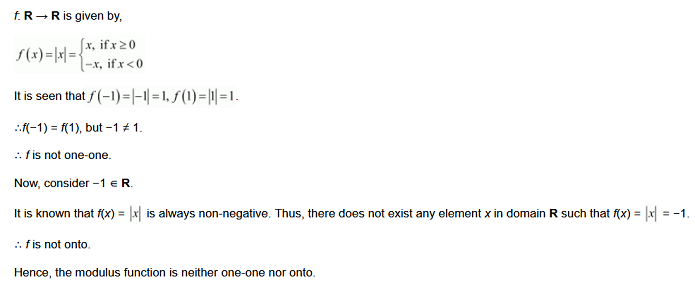
Question5. Show that the Signum Function f: R → R, given by
is neither one-one nor onto.
Solution :
f: R → R

It is seen that f(1) = f(2) = 1, but 1 ≠ 2.
∴ f is not one-one.
Now, as f(x) ) takes only 3 values (1, 0, or −1) for the element −2 in co-domain R , there does not exist any x in domain R such that
f(x) = −2.
∴ f is not onto.
Hence, the signum function is neither one-one nor onto.
Question6. Let A = {1, 2, 3}, B = {4, 5, 6, 7} and let f = {(1, 4), (2, 5), (3, 6)} be a function from A to B. Show that f is one-one.
Solution :
It is given that A = {1, 2, 3}, B = {4, 5, 6, 7}.
f: A → B is defined as f = {(1, 4), (2, 5), (3, 6)}.
∴ f (1) = 4, f (2) = 5, f (3) = 6
It is seen that the images of distinct elements of A under f are distinct.
Hence, function f is one-one.
Question7. In each of the following cases, state whether the function is one-one, onto, or bijective. Justify your answer.
(i) f: R → R defined by f(x) = 3 − 4x
(ii) f: R → R defined by f(x) = 1 + x2
Solution :

Question8. Let A and B be sets. Show that f: A × B → B × A such that (a, b) = (b, a) is a bijective function.
Solution :
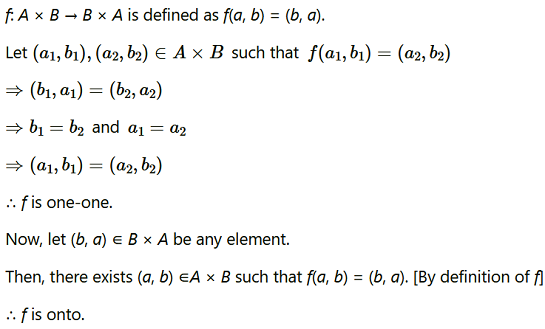
Question9. Let N → N be defined by f(n) for all

State whether the function f is bijective. Justify your answer.
Solution :

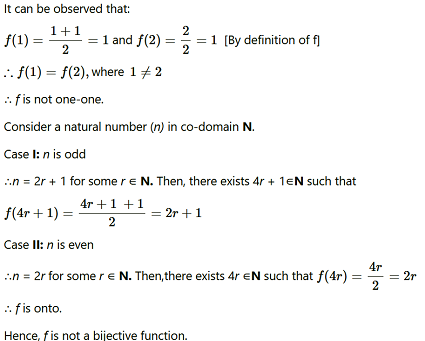
Question10. Let A = R – {3} and B = R – {1}. Consider the function f : A → B defined by f(x) = (x-2/x-3) Is f one-one and onto? Justify your answer.
Solution :
A = R – {3} and B = R – {1}
f : A → B defined by f(x) = (x-2/x-3)
Let x, y ∈ A such that f(x) = f(y)
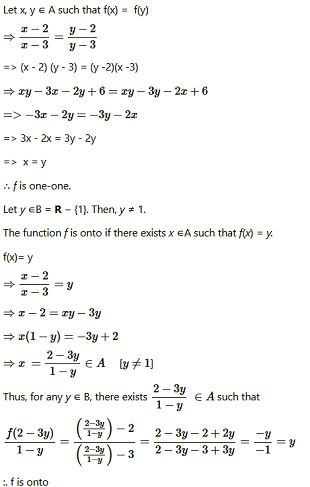
Hence, function f is one-one and onto.
Question11. Let f: R → R be defined as f(x) = x4. Choose the correct answer.
(A) f is one-one onto
(B) f is many-one onto
(C) f is one-one but not onto
(D) f is neither one-one nor onto
Solution :
f: R→ R is defined as f(x) = x4.
Let ,x, y ∈ R such that f(x) = f(y).
⇒ x4 = y4
⇒ x = ±y
∴f(x1) = f (x2) does not imply that x1 = x2
For instance,
f(1) = f(-1) = 1
∴ f is not one-one.
Consider an element 2 in co-domain R . It is clear that there does not exist any x in domain R such that f(x) = 2.
∴ f is not onto.
Hence, function f is neither one-one nor onto.
The correct answer is D.
Question12. Let f: R → R be defined as f(x) = 3x. Choose the correct answer.
(A) f is one-one onto
(B) f is many-one onto
(C) f is one-one but not onto
(D) f is neither one-one nor onto
Solution : f: R → R be defined as f(x) = 3x.
Let ,x, y ∈ R such that f(x) = f(y).
⇒ 3x = 3y
⇒ x = y
∴ f is one – one
Also, for any real number (y) in co-domain R, there exists y/3 in R such that f(y/3) = 3(y/3) = y
∴ f is onto.
Hence, function f is one-one and onto.
The correct answer is A.